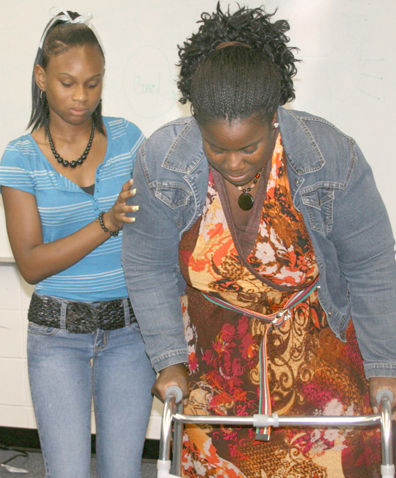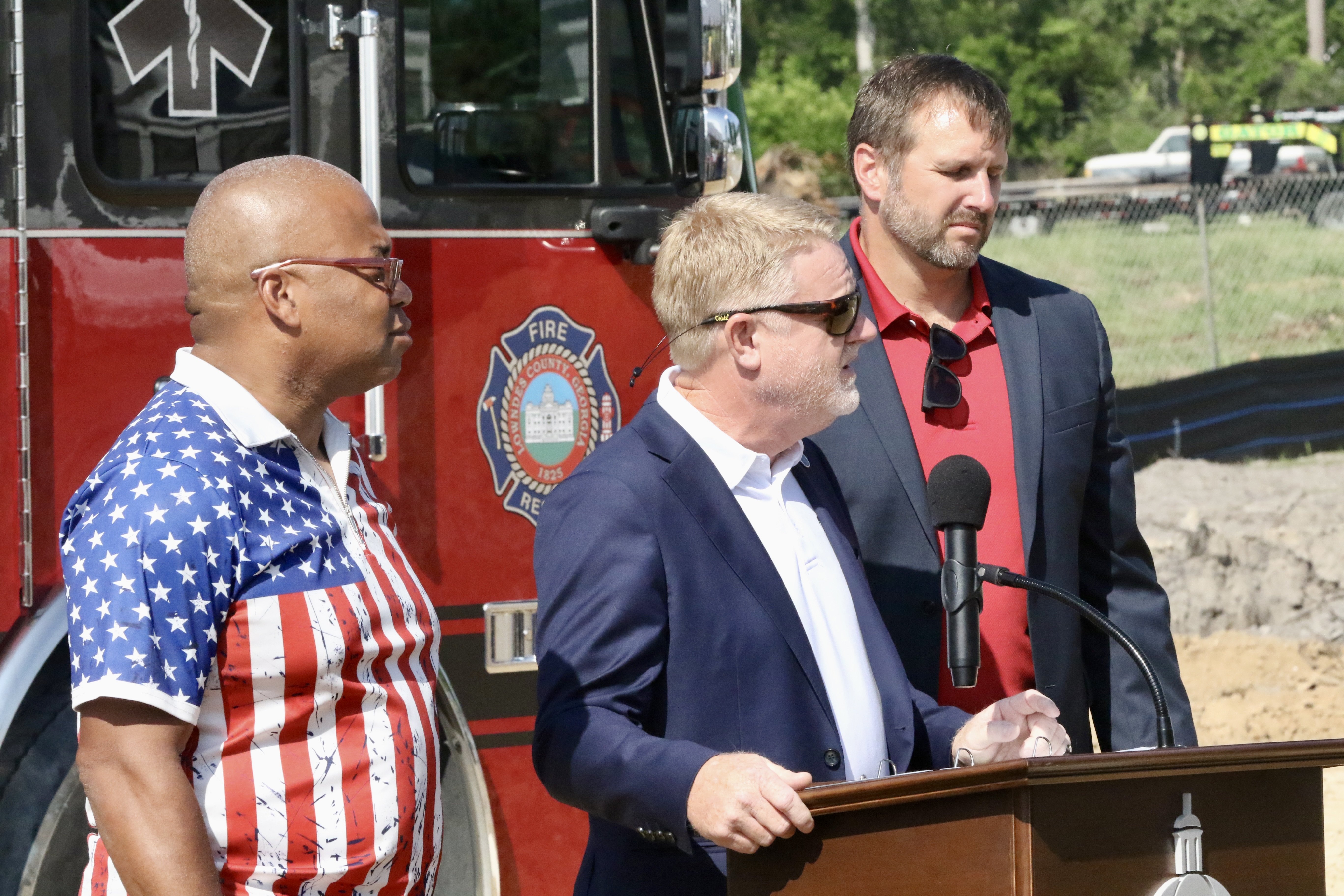Learning patient care skills
Published 11:53 pm Friday, September 5, 2008

- Ashley Reynolds assists Jasmine Jackson with her walker. Students in the patient care assisting class at Brooks County High School learn how to treat and handle future patients by practicing with each other.
QUITMAN — A wheelchair-bound person should be lifted using one’s legs and with the back and neck straight.
If an elderly person starts to fall, a person should not try and catch them, but rather assist in softening the landing.
These are the concepts and training several Brooks County High School students are learning through the Patient Care Assisting program taught by Valdosta Technical College instructor Carolyn Grant.
Grant, a nurse, is one of many instructors from the technical college who teach dual enrollment courses across a six-county coverage area.
Through these classes students can earn college and high school credit and valuable tools to take into a future job.
Bill Tillman, VTC high school services coordinator, has been involved with the early enrollment programs for six years.
“Over the years the technical colleges have always tried to provide these opportunities to high school students to get a head start on some college work,” Tillman said.
The technical college offers three different options for high school students looking to get a jump start on their college education or future career.
“These early enrollment opportunities do a couple of things,” Tillman said. “They give a student the chance to gain some experience in an occupational area and in some cases they can earn both college credit and high school credit by taking one of these courses.”
The dual enrollment opportunities are targeted at occupations that are connected to the local community and the growth potential within those fields, Tillman said.
Even though VTC is still conducting their summer quarter, the technical college has 230 high school students dual enrolled in programs across the service area, Tillman said.
The dual enrollment program offers credit in technical certificate and diploma programs at VTC.
“A lot of students work part-time as they pursue a college education and rather than make minimum wage, they can possibly make a higher salary as they continue their education,” Tillman said.
The Georgia HOPE grant pays the tuition for two of the programs offered to high school students through VTC. The third program, ACCEL, has a separate scholarship program that covers the cost of the class and books, Tillman said.
“In some cases, depending on the option they take, a student might be able to transfer some of these courses to the university system,” Tillman said. “Even a university bound student can gain some education training and career skills that they can utilize.”
The VTC dual enrollment, joint enrollment and ACCEL programs service seven school systems in six counties in South Georgia, Tillman said.
This year the technical college has begun to reach out to the private schools and home schooled students in the area to get them involved in the programs.
All dual enrollment and college credit courses are available to students 16 years or older who meet VTC admission requirements.
Dual Enrollment
Dual enrollment students are enrolled at VTC, taught by VTC instructors and receive credit at both a technical college and high school level.
HOPE grant pays tuition, fees and up to $100 in books for the dual-enrollment courses, as long as the student has been a Georgia resident for 12 months or longer.
The dual enrollment programs offered through VTC include, air conditioning technician assistant, basic paint and body repair, car audio system installer, certified customer service specialist, child development specialist, computer repair technician, criminal justice, nail technician, patient care assisting, production specialist and Web site design associate.
Dual enrollment courses have been offered at BCHS since 2002, said Sharon Cunningham, instructional lead specialist and vocational director.
Heating and air installation, early childhood education, car audio installation and patient care assisting are just a few of the courses that are taught on the BCHS campus that can help a student earn college credit.
In all, the high school offers 19 college credit courses to its students, Cunningham said.
“If a student has college credit when they graduate they are more likely to continue on to Val Tech or another college,” Cunningham said.
Grant is teaching a class of 13 students essential patient care. Upon completion of her class students can take the state test, and if they pass, become a patient care assistant.
Grant said that certification can lead to a variety of jobs in the health services field.
Students in Grant’s class can take the certification test before graduating high school as long as they finish the dual enrollment course she teaches at BCHS.
Those that enter the medical field at this basic level are said to become the best doctors and nurses because they have already mastered the most basic skills of how to talk and handle a patient, Grant said.
The basic concepts of patient care are grasped within the first few weeks, but learning the proper steps in handling an elderly or infirm patient will take the class the rest of the semester to master, Grant said.
Cunningham said they make sure some of their other courses mesh closely with courses taught at VTC so the students are on the right track to succeed in their secondary education.
This has expanded the dual enrollment courses at BCHS to also include horticulture, culinary arts and core classes like math and English.
Student can now take as many dual enrollment courses as they like without the classes affecting the HOPE cap on classes. In May the state Legislature passed a law that prevents college credit courses taken in high school from being counted for the cap.
“This use to be a big concern for parents,” Tillman said. “They were afraid for their kid to use too many hours at the high school level.”
The technical college sends instructors out to the high school campuses during the day to teach the dual enrollment courses. The courses are taught as an elective, he said.
The students go to the class five days a week and will be in the course for one semester.
The entire community, from students to area business leaders, help determine what dual enrollment courses are offered at BCHS, she said.
Students who wish to take dual enrollment classes register in February, Cunningham said.
The students then meet with a VTC representative who discusses with them specific requirements for the course that may be required of the student outside of the classroom setting.
This fall at BCHS, 27 students are currently enrolled in dual enrollment courses. In the spring 55 students will be enrolled, Cunningham said.
Joint Enrollment
If students do not wish to dual enroll and would prefer to take a class at VTC they can be joint enrolled. Much like the dual enrolled program students must be 16 to participate and HOPE will pay for the courses that the student comes out to the technical college and takes in the evening, he said.
“They can take a technical college course with us and earn technical college credit, but that is all they are getting, no high school credit,” Tillman said.
ACCEL
The ACCEL program is very specific and VTC currently has a limited number of courses that fall into the ACCEL program, Tillman said.
ACCEL students must be pursuing a college degree and the scholarship money involved in the program only covers academic core courses that can transfer to a technical institute, college or university, he said.
With the ACCEL program students may only enroll in associate degree level programs. The academic core programs that are ACCEL approved are set by the Georgia Department of Education and the Georgia Student Finance Commission.
Guidelines for the ACCEL program are provided by the Georgia Student Finance Commission.
Students who take the classes under the ACCEL program also earn high school credit for the classes, he said.
Students enrolled in the ACCEL program are awarded the ACCEL award which pays for tuition, fees and a book allowance.
If students meet required SAT and GPA requirements ACCEL courses could qualify for transfer to the university system.
“One of the exciting things about the ACCEL option is, because of our SACS accreditation, there are some opportunities for some of those courses to transfer to VSU,” Tillman said, “If student meets the transfer requirements that the university requires.”
More information about dual enrollment and ACCEL can be found at www.valdostatech.edu.





